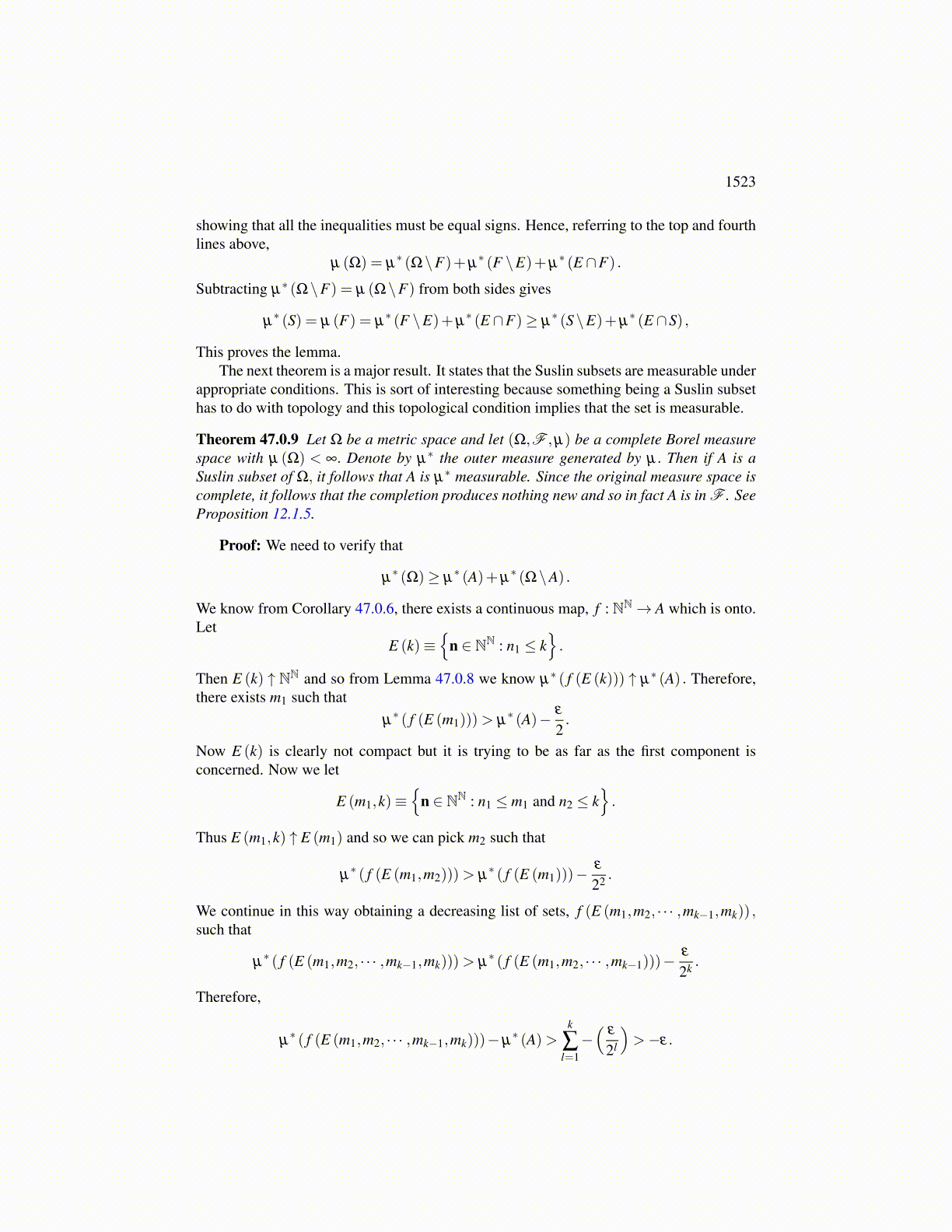
1523
Lemma 47.0.7 Let X be a Suslin space and suppose Xi is a subspace of X which is also aSuslin space. Then ∪∞
i=1Xi and ∩∞i=1Xi are also Suslin spaces. Also every Borel set in X is
a Suslin space.
Proof: Let fi : Zi→ Xi where Zi is a polish space and fi is continuous and onto. Withoutloss of generality we may assume the spaces Zi are disjoint because if not, we could replaceZi with Zi×{i} . Now we define a metric, ρ, for Z ≡ ∪∞
i=1Zi as follows.
ρ (x,y)≡ 1 if x ∈ Zi,y ∈ Zk, i ̸= k
ρ (x,y)≡ di (x,y)1+di (x,y)
if x,y ∈ Zi.
Here di is the metric on Zi. It is easy to verify ρ is a metric and that (Z,ρ) is a polish space.Now we define f : Z→∪∞
i=1Xi as follows. For x ∈ Zi, f (x) ≡ fi (x) . This is well definedbecause the Zi are disjoint. If y is very close to x it must be that x and y are in the same Ziotherwise this could not happen. Therefore, continuity of f follows from continuity of fi.This shows countable unions of Suslin subspaces of a Suslin space are Suslin spaces.
If H ⊆ X is a closed subset, then, letting f : Z→ X be onto and continuous, it followsf : f−1 (H)→ H is onto and continuous. Since f−1 (H) is closed, it follows f−1 (H) is apolish space. Therefore, H is a Suslin space.
Now we show countable intersections of Suslin spaces are Suslin. It is clear that θ :∏
∞i=1 Zi→∏
∞i=1 Xi given by θ (z)≡ x = {xi} where xi = fi (zi) is continuous and onto, this
with respect to the usual product topology. Note that ∏∞i=1 Zi is a polish space because of
the assumption that each Zi is and the above considerations. Therefore, ∏∞i=1 Xi is a Suslin
space. Now let P ≡{
y ∈∏∞i=1 fi (Zi) : yi = y j for all i, j
}(This is how you get it on the
intersection. I guess this must be the case where each Xi ⊆ X). Then P is a closed subspaceof a Suslin space and so it is Suslin. Then we define h : P→ ∩∞
i=1Xi by h(y) ≡ fi (yi) .This shows ∩∞
i=1Xi is Suslin because h is continuous and onto. (h◦θ : θ−1 (P)→∩∞
i=1Xi iscontinuous and θ
−1 (P) being a closed subset of a polish space is polish.)Next let U be an open subset of X . Then f−1 (U) , being an open subset of a polish
space, can be obtained as an increasing limit of closed sets, Kn. Therefore, U =∪∞n=1 f (Kn) .
Each f (Kn) is a Suslin space because it is the continuous image of a polish space, Kn.Therefore, by the first part of the lemma, U is a Suslin space. Now let
F ≡{
E ⊆ X : both EC and E are Suslin}.
We see that F is closed with respect to taking complements. The first part of this lemmashows F is closed with respect to countable unions. Therefore, F is a σ algebra and so,since it contains the open sets, must contain the Borel sets.
It turns out that Suslin spaces tend to be measurable sets. In order to develop this idea,we need a technical lemma.
Lemma 47.0.8 Let (Ω,F ,µ) be a measure space and denote by µ∗ the outer measuregenerated by µ. Thus
µ∗ (S)≡ inf{µ (E) : E ⊇ S, E ∈F} .